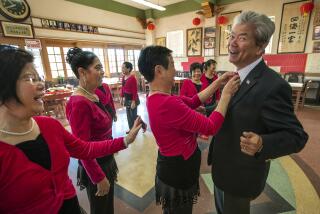Gymkhana Club Based in Another Era
- Share via
NEW DELHI — When security officials became worried that the prime minister’s residence wasn’t sufficiently guarded, they looked across the wall of his compound and announced that they needed to take some land from the club on the other side.
They should have known better.
Yes, the prime minister commands 1 million soldiers and oversees the world’s second-most populous nation. But the Delhi Gymkhana Club, with its grass tennis courts, wooden dance floor and generations of tradition, wields its own sort of clout.
“We’re not an ordinary club,” said O.P. Malhotra, the retired army colonel who runs the institution where power has gathered for more than a century, back to the days when the only Indians allowed in were serving drinks to young British colonials.
The increasingly modern India has barely touched it, and only recently has it seen a new generation of profit-seekers open the door, just a bit, to change.
Little is ordinary about the aggressively elitist outpost that draws its 5,000 active members from across the upper tiers of Indian life.
Past the club gates, where uniformed guards stand waiting to salute, is what remains of an India that disappeared more than half a century ago, an island of genteel snobbery shaped by its onetime colonial rulers and fully conscious of its own contradictions.
It’s a place where cabinet ministers, business leaders and prominent intellectuals wallow in traditions any Edwardian gentleman would understand: leisurely card games, reading in the book-filled library, whiskies sipped among friends.
It’s an Indian club where the accents sound more like Oxford than Delhi, where traditional Indian clothing is scorned, and where Indian food, famous elsewhere for its spiciness, is as bland as an English pub breakfast.
“Brown sahibs,” the members are sometimes called -- although only behind their backs -- for their love of all things associated with the colonial “sahibs” who once ruled India.
But like a child born into privilege, the Gymkhana is also a place that’s comfortable with its own power.
“Anyone who is anyone in this country belongs,” said Malhotra, only slightly exaggerating.
Prime Minister Manmohan Singh, for instance, and many of his cabinet officials are members. Atal Bihari Vajpayee, Singh’s predecessor during the abortive land grab, doesn’t belong, but his top deputies regularly lunched there during his tenure.
So when the club was told to give up a chunk of its 27-acre compound, plenty of powerful people were displeased.
After months of wrangling, the dispute was finally resolved late last year. Few were surprised at the outcome.
“They didn’t get one centimeter from us, not one centimeter,” said Malhotra, smiling triumphantly as he leaned back in his enormous desk chair.
At the Gymkhana, they’ll tell you, change is sacrilege.
“The waiters here know my name; they know my children’s names,” said Shankar Prasad, a retired general, clapping his hands sharply for a drink in the frigidly air-conditioned bar. “The people who work in the squash courts are the fourth generation. I used to play with their grandfathers.
“It would be a great loss if we lost these traditions,” he said.
Some members, though, see change slowly intruding, carried in by a small but growing coterie of the nouveaux riches.
“These billionaires are coming around these days, splashing around their money,” said V.P. Chawla, a technocrat retired from the government power company. “We are a very frugal crowd.”
The new crowd, though, is not. They tip the staff (very much frowned upon), openly network for new business and talk loudly about their money.
They are the factory owners, bankers and international businessmen who are feeding India’s economic boom, shopping at glass-walled malls, and building baroque homes of mirrors and polished marble.
Their arrival at the club reflects a changing India, where post-independence socialist ideals have given way to globalized trade, and an upper class once dominated by intellectuals and bureaucrats has given way to profit-seekers.
“The older generation people like me, we don’t like to see changes,” Chawla said. “But what can we do? We have to join the 21st century.”
In most ways, though, the Gymkhana remains in an earlier time.
Waiters in bowties still serve afternoon tea at the edge of the dance floor, even if it’s delivered these days on plastic trays, and hunting scenes of the British countryside still hang above the fireplaces.
Outside, the carefully tended gardens remain an oasis of calm in a frenetic capital. Nannies and other personal servants, signs warn, “are only allowed in the children’s park.”
Mornings in the century-old main building are filled with the gentle clatter of ceiling fans and the crashing sounds of servants sorting cutlery for lunch.
Here, tweed is far more common than the loose fitting tunics called kurtas that millions of Indian men wear every day. They’re allowed under club rules but are clearly unwelcome.
“Gentleman don’t wear kurtas outside the home,” Prasad, the retired general, said with a sniff.
And being a gentleman is what it’s all about. New members are chosen for their “clubability” -- a mix of family background, professional history and social manners -- and outsiders are expected to keep a respectful distance.
It’s the nature of an institution that knows its lofty place on the social ladder.
Asked if the Gymkhana is India’s most elite club, Prasad is momentarily stunned, surprised at what he clearly thinks is a foolish question.
“Well,” he said, briefly pausing, “I should think so.”
More to Read
Sign up for Essential California
The most important California stories and recommendations in your inbox every morning.
You may occasionally receive promotional content from the Los Angeles Times.













